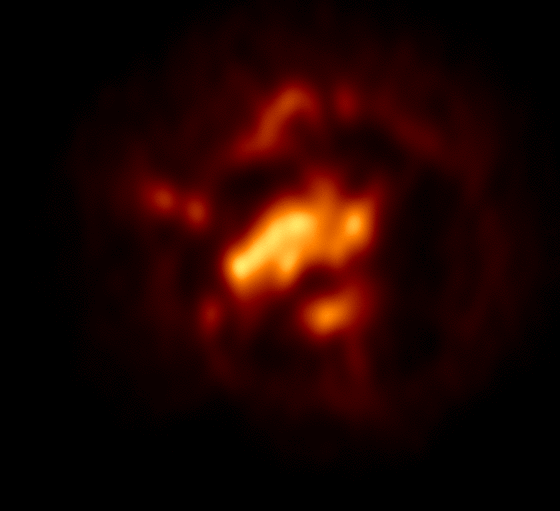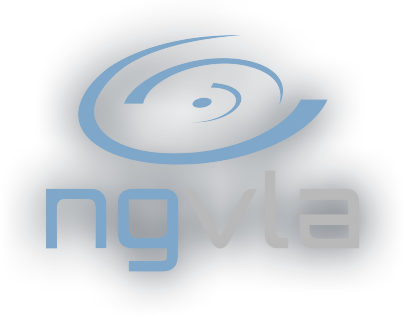ngVLA Community Studies Program Call for Proposals

Image Credit: K. Akiyama & L. Matthews (ngVLA Memo #66)
News • November 11th, 2020
ngVLA Community Studies Program: Call for Proposals
Summary
As the ngVLA Project heads towards the completion of its Conceptual Design, the National Radio Astronomy Observatory (NRAO) is pleased to announce this call for proposals in the fourth of a series of the ngVLA Community Studies Program. These Community Studies are designed to further develop the most pressing science questions that can be addressed by the next-generation centimeter- and millimeter-wavelength radio telescope, the next-generation Very Large Array (ngVLA). As with previous rounds, we expect that all accepted Community Studies efforts write up their findings as part of a peer-refereed journal article or ngVLA memo, and present their progress/final results at an appropriate science meeting, such as the 2022 Winter AAS. Consequently, we anticipate to be able to fund most formally accepted proposals at a modest level to offset possible travel expenses to present results as well as for page charges from publications expected to result from the study. Furthermore, we expect to fund a small number of these Community Studies at a more significant level (up to $30,000 per award) through the ngVLA Community Studies Grants (CSGs) program. A list of past awards can be found at the main ngVLA Community Studies Program page. Please see the full Call for Proposals below:
Call for Proposals
Inspired by the dramatic discoveries from the Jansky Very Large Array (VLA) and the Atacama Large Millimeter/submillimeter Array (ALMA), the National Radio Astronomy Observatory (NRAO) has engaged the broad scientific and technical communities in the design of a next-generation Very Large Array (ngVLA), a large-scale research infrastructure project under development for the National Science Foundation Astronomical Sciences Division (NSF-AST) through a cooperative agreement with Associated Universities, Inc. Building on the superb cm/mm observing conditions and existing infrastructure of the VLA site, the ngVLA is envisaged as an interferometric array with ten times greater sensitivity and spatial resolution than the current VLA and ALMA, operating in the frequency range of 1.2 – 116 GHz. The ngVLA will also greatly expand current U.S. VLBI capabilities by both replacing existing VLBI antennas/infrastructure with ngVLA technology and adding additional stations on 1000 km baselines to bridge the gap between baselines across the U.S. Southwest and present VLBA baselines. In doing so, the ngVLA will be a transformative, multi-disciplinary scientific instrument capable of opening a new window on the Universe through ultra-sensitive imaging of thermal line and continuum emission down to milliarcsecond-scale resolution, as well as unprecedented broad-band continuum polarimetric imaging of non-thermal processes (e.g., the formation and evolution of stellar and supermassive blackholes in the era of multi-messenger astronomy).
Given the success of our three previous rounds of ngVLA Community Studies, we are proud to announce a fourth round aimed at tackling some of the most pressing questions unveiled by the initial studies. ngVLA Community studies provide a mechanism for members of the community to become major contributors to this effort. This fourth round of studies will be carried out over the next year and be used to help inform the ngVLA Conceptual Design that will be considered as an NSF Major Research Equipment and Facilities Construction (MREFC) candidate. As with the previous rounds, each study will be given an NRAO contact scientist, who will provide the investigators with information they may need to carry out the study, as well as monitor the progress of the investigation.
A successful ngVLA Community Studies project should:
(i) Demonstrate the major scientific/technical advancement being advocated and put it in context for the broader astronomical community.
(ii) State clearly the impact on design choices.
(iii) Ultimately produce a publication in a peer-refereed journal, or at minimum in the ngVLA memo series.
Over the past four years, the U.S. and international astronomy communities have taken a preliminary look at a number of scientific and technical issues that play major roles driving the telescope deign, many of which have been documented in our memo series. A list of past awards can be found at the main ngVLA Community Studies Program page. The primary objective for this fourth round of community studies is to address a number key scientific and technical needs to ensure that the ngVLA will achieve the Key Science Goals outlined in Memo #19. Studies and simulations should focus on better quantifying the expected performance of the array for addressing these key science goals and provide additional supporting technical requirements as necessary.
We will entertain proposals in any area of astronomical or other usages of the ngVLA. A few examples of study topics that may support these goals and are of interest to the project are listed below, however proposals are not limited to these areas:
- Expand on current Solar System Science that can be carried out with the ngVLA, including science what can be achieved via planetary radar.
- Imaging algorithmic development, such as new weighting schemes to achieve the highest possible sensitivity and fidelity at a given resolution both for line and continuum imaging cases.
- Provide an analysis and describe the potential impact of Low Earth Object (LEO) satellite constellations (e.g., SpaceX, WebOne).
- Identify areas where the ngVLA can make a significant impact for SETI, such as the identification of possible techno-signatures.
- Look at the role that the ngVLA can play, especially when including the Long Baseline Array (LBA), for Space Situational Awareness (SSA) work and identify any missing requirements.
- Expand on existing ngVLA Milky Way and nearby galaxy science, such as the array's requirements for mosaic/on-the-fly imaging that may require short spacing information from the Short Baseline Array (SBA) and total power information.
- Expand on the current ngVLA science related studying the evolution of high-redshift galaxies, specifically characterizing their sizes, energetics, kinematics, and molecular gas properties. This may include the usage of uv-plane vs. image-plane stacking techniques.
- Expand on the existing ngVLA science cases related to observations of Sgr A* to further our understanding of fundamental physics.
- Polarization studies, looking into potential issues of array extent and varying parallactic angle, systematic errors & calibration.
We expect that all accepted Community Studies efforts write up their findings as part of a peer-refereed journal article or an ngVLA memo, and present their progress/final results at an appropriate science meeting, such the 2022 January AAS. Consequently, we anticipate to be able to fund most formally accepted proposals at a modest level to offset travel expenses to present results, as well as for page charges from publications expected to result from the study. We additionally expect to fund a small number of these Community Studies at a more significant level (up to $30,000 per award) through the ngVLA Community Studies Grants (CSGs) program. Proposals requesting financial support beyond $30,000 must be extremely well justified. Those who expect to require additional funding, please see the Funding Terms and Conditions for the CSGs. Proposals requesting funding will be reviewed by members of the ngVLA Science Advisory Council.
| Date | Activity |
|---|---|
| November 9, 2020 | Call for Proposals Announced |
| December 16, 2020 (1:00PM EST) | ngVLA Town Hall |
| January 15, 2021 | Submission Deadline |
| February 1, 2021 | Announce/Fund Accepted Proposals |
| September 15, 2021 | Submission of Final Reports (Publication/ngVLA Memo) |
Submission Process
Proposals, consisting of a single PDF (no more than 2 pages for Basic Studies and 5 pages for Funded Studies, see below), should be emailed to ngVLA-CSP@nrao.edu no later than January 15, 2021. In your email, please include the following:
- PI Name and Affiliation:
- PI Email Address:
- Title of Proposed Study:
- List of Co-Investigators:
- Identify if this is a Science or Technical study:
- Requesting Additional Funding (Y/N):
- Proposal Abstract:
We expect to approve programs by February 1, 2021. As stated above, all proposals should detail how their Community Studies program will:
(i) Demonstrate the major scientific/technical advancement being advocated in your study and clearly put its impact in context for the broader astronomical community.
(ii) Describe (as quantitatively as possible) how their findings impact the design choices of the array.
(iii) A brief workplan identifying who will be carrying out most of the study (e.g., students/post-docs).
(iv) A list of expected deliverables to NRAO by the end of the program in Summer 2021, to include a written report that will be submitted to either peer-refereed journal or the ngVLA memo series.
Basic Studies
We will again accept studies that do not actually request any additional funding. For these studies, we ask that you submit a two-page description of the work that addresses the above mentioned topics. These descriptions will allow the project office to keep track of the multiple threads relating to ngVLA development across the community and coordinate with internal efforts.
Studies Requiring Additional Funding
For those requesting financial support to carry out their Community Study, we ask that you submit a 5-page proposal: The first four pages should provide an in-depth explanation of your planned study, including a detailed description of the proposed work and corresponding deliverables as highlighted above. The fifth page should include your proposed budget and corresponding budget narrative. For guidance on budget preparation, see the Funding Terms and Conditions for the CSGs below.
CSGs Funding Terms and Conditions
- Those Community Studies proposals requiring funding will be accepted from principal investigators or co-investigators who are employed at U.S. institutions.
- Funding will be awarded for a period of ~6 months. Award activation will commence immediately after a proposal is accepted.
- The funding cap for stipends is $25,000 with an additional amount of up to $5,000 for miscellaneous expenses (computer hardware and/or travel to domestic meetings to present study findings). Administrative costs may be budgeted into (not added to) the stipends to offset the costs of administering the award by the investigator's institution. The administrative costs may be no more than 10 percent of the stipends. Tuition costs are not allowed. Fringe benefits are allowed. Domestic meeting locations include those within the US and its territories, within Canada, or within Mexico. Tickets for air travel must be purchased from US flag carriers, defined as those holding certificates under section 401 of the Federal Aviation Act of 1958 (49 U.S.C. 1371).
- A close out report to the ngVLA Project Director must be submitted at the expiration of the award.




